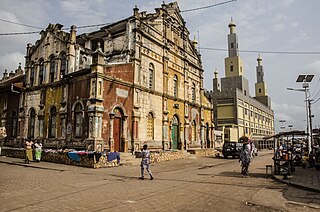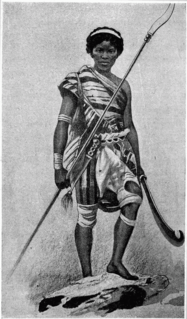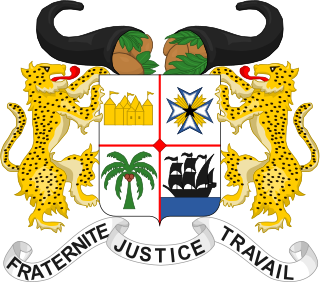Related Research Articles

Benin, officially the Republic of Benin and formerly known as Dahomey, is a country in West Africa. It is bordered by Togo to the west, Nigeria to the east, Burkina Faso to the north-west, and Niger to the north-east. The majority of its population lives on the small southern coastline of the Bight of Benin, part of the Gulf of Guinea in the northernmost tropical portion of the Atlantic Ocean. The capital of Benin is Porto-Novo, but the seat of government is in Cotonou, the country's largest city and economic capital. Benin covers an area of 114,763 square kilometres (44,310 sq mi) and its population in 2018 was estimated to be approximately 11.49 million. Benin is a tropical nation, highly dependent on agriculture, and is a large exporter of palm oil and cotton. Substantial employment and income arise from subsistence farming.

The Kingdom of Dahomey was a West African kingdom located within present-day Benin that existed from approximately 1600 until 1904. Dahomey developed on the Abomey Plateau amongst the Fon people in the early 17th century and became a regional power in the 18th century by conquering key cities on the Atlantic coast.

Porto-Novo is the capital of Benin. The commune covers an area of 110 square kilometres (42 sq mi) and as of 2002 had a population of 223,552 people.

French West Africa was a federation of eight French colonial territories in West Africa: Mauritania, Senegal, French Sudan, French Guinea, Ivory Coast, Upper Volta, Dahomey and Niger. The federation existed from 1895 until 1958. Its capital was Saint-Louis, Senegal until 1902, and then Dakar until the federation's collapse in 1960.

The national flag of Benin is a flag consisting of two horizontal yellow and red bands on the fly side and a green vertical band at the hoist. Adopted in 1959 to replace the French Tricolour, it was the flag of the Republic of Dahomey until 1975, when the People's Republic of Benin was established. The new regime renamed the country and changed the flag to a green field with a red star in the canton. This version was utilized until the regime collapsed in 1990, coinciding with the Revolutions of 1989. The new government promptly restored the original pre-1975 flag.

The Fon people, also called Fon nu, Agadja or Dahomey, are a Gbe ethnic group. They are the largest ethnic group in Benin found particularly in its south region; they are also found in southwest Nigeria and Togo. Their total population is estimated to be about 3,500,000 people, and they speak the Fon language, a member of the Gbe languages.

The Dahomey Amazons were a Fon all-female military regiment of the Kingdom of Dahomey which existed until 1904. They were so named by Western observers and historians due to their similarity to the mythical Amazons of ancient Anatolia and the Black Sea. This unusual emergence of an all-female military regiment was the result of Dahomey's male population facing high casualties in frequent warfare with neighboring West African states, as well as Dahomey being forced to annually give male slaves to the Oyo Empire. The lack of men likely led the kings of Dahomey to recruit women into the army.

The Slave Coast is a historical name formerly used for that part of coastal West Africa along the Bight of Benin that is located between the Volta River and the Lagos Lagoon. The name is derived from the region's history as a major source of African people sold into slavery during the Atlantic slave trade from the early 16th century to the late 19th century.

The Communist Party of Benin is a communist party in Benin. PCB was founded in 1977 by the Union of Communists of Dahomey. The party was initially called Communist Party of Dahomey. The first secretary of the party is Philippe Noudjenoume. PCB publishes La Flamme.

Say is a department of the Tillabéri Region in Niger. Its capital city is Say, and includes the towns of Guéladjo, Tamou, and Torodi. It abuts the urban Region of Niamey, and lies across the Niger River to the southwest of the capital. It extends to the Burkina Faso border over 60 km to the west, and the northernmost border with Benin in the south. The Say area is today divided between the riverine valley in the east of the Department, and the more sparsely populated areas to the west, which are intercut with a series of eastward flowing tributaries. The Niger river, a broad shallow channel at Niamey and at Say, passes through a series of gorges and cataracts, called the "W" bend for the shape the river takes, in the south of the Say Department. To the west of these rapids lies what is now the W Regional Park, a sparsely populated area historically plagued by insect borne diseases of both humans and cattle. Now a park and tourist attraction, its history as a "no mans land" has made it a refuge for remaining wild animals, as well as several undisturbed archeological sites. From at least the 16th century CE, the Songhai proper moved south into this area from the north around what is now Tera. The inhabitants at the time were related to the Gourma people, who form most of the population of the northwestern part of the Department today. In the 18th and 19th century, the town of Say was founded by Fulani migrants from the Gao region of modern Mali, with others expanding from what is now northeast Burkina Faso. Between 1810 and the arrival of European writer Heinrich Barth in 1854, Fulani Muslims led by Alfa Mohamed Diobo of Djenné had established the Emirate of Say. The reputation for piety and learning of Mohamed Diobo and his followers helped turn Say from a small river village into a town of 30,000, famed across West Africa as a center of learning.
Maximilien Quenum-Possy-Berry, Légion d'honneur was a politician who served as a Senator of the Fourth Republic, representing Dahomey in the French Senate from 1955 to 1958. He was also a teacher of philosophy and a writer on ethnology.
La Presse Porto-Novienne was a French language weekly republican socialist newspaper published from Porto-Novo, Dahomey. The newspaper was founded in 1931 by Vincent Moreira Pinto. It carried subtitles in Yoruba language, and had a Yoruba language section.
Antoine-Marie-Auguste Frézouls was a French colonial administrator who was Lieutenant Governor of French Guinea from September 1904 to March 1906.
Le Guide du Dahomey was a short-lived but influential newspaper in Dahomey. The paper was published weekly from Cotonou between 1920 and 1922 over 88 issues under the editorship of Dorothée Lima and Jean Adjovi. Its critical tone and regular production paved the way for the expansion of Dahomean media from the 1920s onwards.
Dorothée Joaquim Lima was a newspaper editor and publisher in Dahomey who was instrumental in the development of news media in Dahomey during the French colonial era. With Jean Adjovi he edited the influential but short-lived Le Guide du Dahomey (1920-22). Later, he replaced Jean Adjovi as the editor of La Voix du Dahomey.
The following is a timeline of the history of the city of Cotonou, Benin.
Louis Hunkanrin was a Dahomeyan writer, educator, journalist, and politician. He was one of the earliest critics of French colonial power in his country, later renamed Benin.

Benin–Turkey relations are the foreign relations between Benin and Turkey. Turkey has an embassy in Cotonou since 2014, while the Beninois embassy in Ankara opened in 2013, however the embassy was closed in 2020.

Beninese nationality law is regulated by the Constitution of Benin, as amended; the Beninese Nationality Code, and its revisions; the Family Code; and various international agreements to which the country is a signatory. These laws determine who is, or is eligible to be, a national of Benin. The legal means to acquire nationality, formal legal membership in a nation, differ from the domestic relationship of rights and obligations between a national and the nation, known as citizenship. Beninese nationality is typically obtained under the principle of jus sanguinis, i.e. by birth in Benin or abroad to parents with Beninese nationality. It can be granted to persons with an affiliation to the country, or to a permanent resident who has lived in the country for a given period of time through naturalisation.
References
- ↑ Manning, Patrick (2004). Slavery, Colonialism and Economic Growth in Dahomey, 1640-1960. Cambridge: Cambridge University Press. p. 267. ISBN 978-0-521-52307-3.
- ↑ J. D. Fage; A. D. Roberts; Roland Anthony Oliver (1986). The Cambridge History of Africa Vol. 7 c. 1905 - c. 1940. Cambridge: Cambridge University Press. p. 389. ISBN 978-0-521-22505-2.
- ↑ Campbell, W. Joseph (1998). The Emergent Independent Press in Benin and Côte D'Ivoire: From Voice of the State to Advocate of Democracy. Westport: Praeger. p. 33. ISBN 978-0-275-96309-5.
- ↑ Campbell, 1998, p. 31.